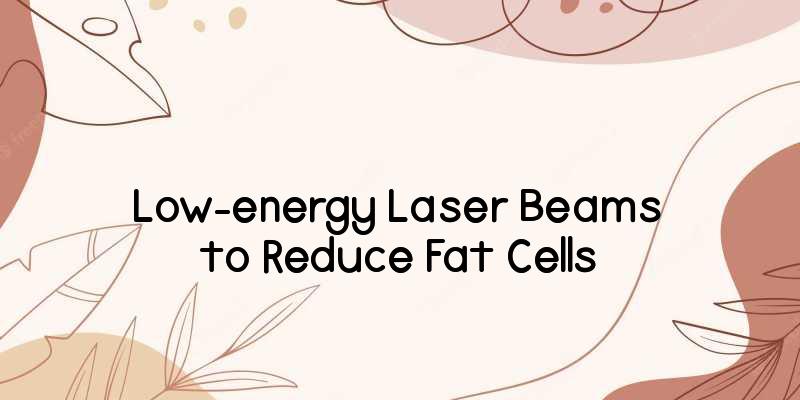10 Innovative Fat Reduction Techniques Ideas
Posted on: January 16, 2023

Developing a non-invasive fat reduction technique that uses low-energy laser beams to selectively target and reduce fat cells.
The non-invasive fat reduction technique would use low-energy lasers to selectively target and reduce fat cells. The laser beams would penetrate the skin and target the fat cells, causing them to break down and be naturally eliminated by the body. The laser beams would be carefully calibrated to ensure that only the fat cells are affected, while leaving the surrounding tissue unharmed. The treatment would be painless and have minimal side effects, making it an attractive option for those seeking to reduce fat without surgery.

Creating a new type of liposuction procedure that is less invasive and has fewer side effects.
The new procedure would involve the use of a small, thin cannula that is inserted with minimal incisions. The cannula would be guided by ultrasound imaging to target fat deposits. The cannula would then be used to suction out the fat while simultaneously delivering a cooling agent, such as saline solution, to the area to reduce inflammation and swelling. The cannula would also be equipped with a filter to catch any debris or fat particles that may be released during the procedure. This new procedure would be less invasive and have fewer side effects than traditional liposuction.
Developing a device that uses ultrasound waves to disrupt and reduce fat cells.
This concept is not yet available as a commercially viable product. However, research is being conducted to explore the potential of using ultrasound waves to target and reduce fat cells. Ultrasound waves can be used to cause cavitation, which is the formation of tiny bubbles in liquid. When these bubbles collapse, they create localized areas of high pressure that can disrupt fat cells. This process has been studied in the context of non-invasive fat reduction treatments, though further research is needed to determine its effectiveness. Additionally, the safety of these treatments must be evaluated before they can be offered to the public.
Investigating the use of cold temperatures to reduce fat cells in targeted areas.
Cold temperatures have been used to reduce fat cells in targeted areas, such as the abdomen and thighs. This process, known as cryolipolysis, involves using a device to cool the fat cells to a certain temperature. This causes the fat cells to die off without damaging the surrounding tissue. The body then naturally removes the dead fat cells over the course of a few weeks.
Studies have shown that cryolipolysis can be effective in reducing fat cells in targeted areas. In one study, participants experienced a reduction in fat cells in the abdomen and thighs after a single treatment. The results were sustained for up to four months after the treatment. Other studies have found similar results.
Overall, cryolipolysis appears to be a safe and effective way to reduce fat cells in targeted areas. However, more research is needed to determine the long-term effects of the procedure.
Benefits vs Risks of cryolipolysis
|
Benefits
|
Risks
|
|
Non-invasive procedure
|
Skin irritation
|
|
Little to no downtime
|
Swelling
|
|
Safe and effective
|
Bruising
|
|
Long-lasting results
|
Numbness
|
Developing a drug that can be taken orally to reduce fat cells.
The first step in developing a drug to reduce fat cells is to identify the target molecule or molecules that will be impacted by the drug. This could be done through research into the biochemistry of fat cells and the metabolic pathways involved in fat storage. Once the target molecule has been identified, the next step is to develop a compound that can interact with the target molecule and reduce fat storage. This could involve screening compounds in a laboratory setting to identify those that are able to interact with the target molecule and reduce fat storage.
Once a compound has been identified, it must then be tested in animal models to determine its safety and efficacy. If the compound is found to be safe and effective in animal models, it can then be tested in clinical trials to determine its safety and efficacy in humans. If the compound is found to be safe and effective in humans, it can then be approved for use as a drug.
Finally, the drug must be manufactured and packaged for distribution. This process involves ensuring that the drug is formulated correctly and that it meets all regulatory requirements. Once the drug is approved, it can be released to the public for use.
Exploring the use of radiofrequency waves to melt fat cells.
Radiofrequency (RF) waves are used in a variety of medical treatments, including noninvasive fat reduction. This technology works by using thermal energy to gently heat the fat cells, causing them to break down and be eliminated from the body. RF waves can be used to target specific areas of the body, such as the abdomen, thighs, and arms, and can be used to reduce the appearance of cellulite. The procedure is safe and has minimal side effects. It is important to note that RF treatments are not a substitute for healthy lifestyle practices, such as eating a balanced diet and exercising regularly.
Creating a new type of diet that is specifically designed to reduce fat cells.
1. Increase protein intake: Protein is essential for maintaining muscle mass and burning fat. Eating lean protein sources such as fish, chicken, turkey, beans, and low-fat dairy products can help to reduce fat cells.
2. Reduce carbohydrate intake: Carbohydrates are converted into sugar, which can be stored as fat if not used right away. Reducing carbohydrate intake can help to reduce fat cells.
3. Increase fiber intake: Fiber helps to keep you full longer and can help to reduce fat cells. Eating more fruits, vegetables, and whole grains can help to increase fiber intake.
4. Reduce sugar intake: Eating too much sugar can lead to an increase in fat cells. Reducing sugar intake can help to reduce fat cells.
5. Increase healthy fat intake: Eating healthy fats such as avocados, nuts, and olive oil can help to reduce fat cells.
6. Increase physical activity: Regular physical activity can help to burn fat cells and increase muscle mass.
7. Reduce stress: Stress can cause an increase in fat cells. Reducing stress through relaxation techniques, such as yoga or meditation, can help to reduce fat cells.
Developing a new type of exercise program that focuses on targeted fat reduction.
The program would involve a combination of resistance training, aerobic exercise, and nutrition. Resistance training would focus on building muscle mass and creating a caloric deficit by burning more calories than are consumed. Aerobic exercise would be used to burn additional calories and increase heart rate, while nutrition would focus on reducing calorie intake and eating a balanced diet. The program would also focus on targeted fat reduction by using specific exercises that target particular areas of the body. These exercises would be designed to increase muscle mass and reduce fat in those areas. Additionally, the program could include lifestyle modifications such as reducing stress, getting adequate sleep, and reducing alcohol consumption.
Examining the use of stem cells to promote fat reduction in targeted areas.
Stem cells are an exciting area of research, and their potential to promote fat reduction in targeted areas is being explored. Stem cells are a type of cell that can differentiate into other types of cells, and they have the potential to regenerate tissue, which could be used to reduce fat in certain areas. Research is ongoing to explore the use of stem cells to target and reduce fat in specific areas of the body.
One potential method of using stem cells to reduce fat is through liposuction. In this procedure, fat cells are removed from the body and replaced with stem cells, which can then differentiate into other types of cells, including fat cells. This could potentially lead to a reduction in fat in targeted areas.
Another potential method is through the use of stem cells to create fat-burning cells. These cells could be injected into targeted areas, where they would then stimulate the breakdown of fat. This could potentially lead to a reduction in fat in targeted areas.
Finally, stem cells could be used to create new fat cells that are resistant to fat storage. This could lead to a reduction in fat in targeted areas, as the new fat cells would be less likely to store fat.
Overall, the use of stem cells to promote fat reduction in targeted areas is an exciting area of research that holds promise for the future. Further research is needed to determine the efficacy of these methods and to determine the best way to use stem cells to reduce fat in targeted areas.
Investigating the use of light therapy to reduce fat cells.
Light therapy is a promising, noninvasive approach to reduce fat cells. It works by using low-level laser light to penetrate the skin and target fat cells. The light energy causes the fat cells to break down, releasing their contents into the bloodstream, which is then metabolized by the body. Studies have shown that light therapy can reduce fat cells by up to 20%, and it has few side effects. However, more research is needed to determine the efficacy and safety of this approach.




